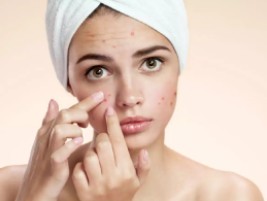About Us


Acne, commonly referred to as
‘pimples’ or ‘zits’, is a very
common and chronic disorder.
Acne
Acne, Best Acne Laser Treatment in Whitefield commonly referred to as ‘pimples’ or ‘zits’, is a very common and chronic disorder. The problem begins in adolescence and can persist well into your 30s. Sometimes women develop acne in their late 30s or 40s, which is called ‘Adult Onset Acne’ and is related to hormonal fluctuations. Once acne begins, it runs its own course of 5-15 years, after which the pimples will cease to appear. Although acne is rarely ever ‘cured’, your dermatologist can help you keep your acne in check, till it runs its natural course and ceases to appear on its own.
Acne is not contagious. It does not reflect your personal hygiene, diet, ‘blood impurities’, digestive problems, masturbation habits or social strata. Contrary to popular belief, there is no association between food and acne. Acne cannot be cured by drinking a lot of water or excessive washing or cleaning. Rather, excessive washing with soap and water is drying and damaging to the skin and can irritate and waterlog the openings of the follicles from which acne arises, and makes acne worse. Washing your face twice a day with recommended cleanser is ideal, and if any more cleaning is desired, it can be done with plain water. You will be doing yourself a great disservice by squeezing or picking on acne. It does not take care of the problem, rather it will leave you with unsightly scars and marks which may become permanent
Oil and cream based moisturizers, certain high SPF sunscreens (SPF 50 and above) and most cosmetics and foundations can aggravate acne. Mild acne in early infancy is considered normal and is a transient phenomenon. Acne involving only the back, is common in tropical areas especially among back-packers. Most people notice that their acne is worse in summers. High humidity can also aggravate acne, and it explains the high incidence of acne among chefs and drivers. Last but not the least, it is important to remember that certain medications can cause acne in adults. These include certain birth control pills, steroids including anabolic steroids, lithium, phenytoin and anti- tuberculosis medication.
Acne can have a hereditary component; which includes age of onset, the distribution of acne, the severity of acne and the tendency to scar. Most patients will report at least one immediate family member who has also suffered from acne.
When acne is seen in association with weight gain, irregular periods, hair thinning and/or excessive facial or body hair in women, an endocrinologist’s opinion must be sought to rule out hormonal disorders like polycystic ovaries.
Not everyone with an acne problem suffers from hormonal “imbalance”. Having said that, your acne IS always controlled by your hormones. In those who are genetically susceptible to acne, their oil glands tend to be very sensitive to regular hormonal fluctuations. Stress, lack of sleep, change in sleep pattern, sedentary life style, weight gain, constipation and poor dietary choices can aggravate acne, by causing hormonal fluctuations. Sugar and dairy products are known to worsen acne. Rarely, some individuals may report worsening of acne with consumption of nuts, protein powders, eggs and/or coffee.
Acne can result in poor self-esteem, social inhibition and loss of job opportunities. Since the problem generally begins in adolescence, the feelings of embarrassment and rejection are very real and traumatic to the sufferer. If ignored, acne can leave behind permanent marks and scars, which are difficult to treat, and may prove to be an economically and emotionally costly affair to the patient.
Skin Changes That Result In Acne
Acne is a disease of the sebaceous (oil) glands, and it arises from the hair follicle to which these glands are attached. The size of these glands is inversely proportional to the diameter of the hair shaft. This is why acne is more common on the face and back, and less common on the scalp. This is also the reason why acne can be caused by epilatory processes like threading or waxing.
These glands produce an oily secretion called sebum, which is responsible for the normal sheen of skin and hair. However in people with acne, this sebum is increased and chemically altered by skin bacteria (appropriately named Propionibacterium Acnes). This altered acne is very sticky, and instead of being smoothly secreted out of the hair follicle, they tend to clump and clog the opening of the hair follicles. This clogged and altered sebum leads to the appearance of black heads and white heads, which are the first stages of acne.
The plugged sebum begins to stretch the follicle. At this point, the pimple feels like a bump in the skin. This provides an ideal environment for the P. Acnes bacteria to fester and multiply, which in turn leads to inflammation. This is the stage where acne presents with pain, heat, redness and pus formation. When the tension inside this pus pocket exceeds, either spontaneously or by manipulation and squeezing, the acne bursts through the skin, discharging the pus inside, and healing with pigmentation and a scar.

Acne, commonly referred to as
‘pimples’ or ‘zits’, is a very
common and chronic disorder.
Treating Acne
The treatment of acne is aimed at dissolving the follicular plug, reducing the oil production, killing the P. Acnes bacteria and reducing inflammation. Different creams and antibiotic tablets can help achieve each of the above-mentioned goals. Large black heads and white heads may have to be manually removed by a trained dermatologist under sterile conditions. Retinoid creams are the mainstay of acne therapy.
First-time retinoid users will experience a mild flare-up of acne in the first 1-2 weeks of treatment, but MUST NOT discontinue the medication, as the fresh crop of acne will resolve on continuing the retinoid. Women who are pregnant or eager to conceive MUST always discuss this with their dermatologist, so that your Doctor can accordingly tailor your prescription. Oral antibiotics or Isotretinoin may be prescribed for severe acne. Our facility also offers anti-acne chemical peels for those who are not keen on, or unsuitable for treatment with antibiotics or Isotretinoin. Women with evidence of hormonal disturbances will have to be evaluated and treated by an endocrinologist as well, in order to maximize the efficacy of the anti-acne therapy.
The redness and mild scaling left after a pimple heals may be obvious in the fair-skinned. However it disappears on its own in 1-2 months and does not require any treatment. In darker-skinned individuals, pimples may heal with residual pigmentation. This can be faded by using medicated creams, chemical peels and/or microdermabrasion. Shallow scars and pits may also be treated with microdermabrasion, which can soften the appearance of scars. Moderately deep scars can be remodeled using dermarollers and fractional resurfacing lasers. These methods are highly dependent on practitioner technique and can result in further scarring in untrained hands.
